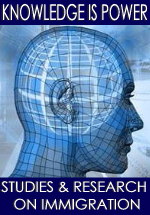Get the Facts on Immigration
The following studies, by various economists and social scientists, represent the best of current thought on immigration and it's effects on society. Most are the work of academics not affiliated with any organizations or advocacy groups. Unlike many of the other studies cited in debates about immigration and immigration reform, these studies were generally done in the spirit of furthering academic knowledge, rather than for effecting legislation or public opinion.
- JOB LOSS:
Comparative Advantages and Gains from Immigration
by Giovanni Peri (University of California, Davis and NBER), Chad Sparber (Colgate University) April, 2007, (Immigrants have little effect on jobs of US high school dropouts. Foreign and native-born workers with similarly low educational attainment in fact compliment each other in the workforce rather than compete. Using forty years of data the study looked at the actual tasks performed by each class of workers to see what jobs were being done by native-born workers as opposed to foreign born workers.The study found that foreign born workers perform more manual and physical tasks, while native-born workers do tasks that are more language-intensive and interactive, and that native-born workers benefit from this specialization) - JOB LOSS:
The Diffusion of Mexican Immigrants During the 1990s: Explanations and Impacts
by David Card, Ethan G. Lewis, NBER Working Paper No. 11552, Issued in August 2005 (low-skilled Mexican immigrants are readily absorbed into the workforce and have little effect on low-skilled native workers.) - JOB LOSS:
Growth in the Foreign-Born Workforce and Employment of the Native Born
by Rakesh Kochhar, Associate Director for Research, Pew Hispanic Center, August 2006, (no relationship between the growth in the foreign-born population and employment outcomes for native-born workers) - JOB LOSS:
The Diffusion of Mexican Immigrants During the 1990s: Explanations and Impacts
by David Card, Ethan G. Lewis, NBER Working Paper No. 11552, Issued in August 2005 (low-skilled Mexican immigrants are readily absorbed into the workforce and have little effect on low-skilled native workers.) - WAGES
Task Specialization, Comparative Advantages, and the Effects of Immigration on Wages, by Giovanni Peri (University of California, Davis and NBER), Chad Sparber (Colgate University). August 2007, National Bureau Of Economic Research, Working Paper No. 13389 (Looking at data for the 50 US states (plus the District of Columbia) from 1960 to 2000 the report shows that foreign-born workers specialize in occupations that require manual tasks such as cleaning, cooking, and building. Immigration causes natives — who have a better understanding of local networks, rules, customs, and language — to pursue jobs requiring interactive tasks such as coordinating, organizing, and communicating. Simulations show that this increased specialization mitigated negative wage consequences of immigration for less-educated native-born workers, especially in states with large immigration flows.) - WAGES & RENTS
The Effects of Immigration on U.S. Wages and Rents: A General Equilibrium Approach, by Gianmarco I.P. Ottaviano, (University of Bologna, FEEM and CEPR), Giovanni Peri, (UC Davis and NBER), Sept, 2007, Centre for Economic Policy Research (This paper documents a strong positive correlation of immigration flows with changes in average wages and average house rents for native residents across U.S. states.. Separating the effects of immigrants on natives of different schooling levels we find positive effects on the wages and rents of highly educated and small effects on the wages (negative) and rents (positive) of less educated. We propose a model where natives and immigrants of three different education levels interact in production in a central district and live in the surrounding region. In equilibrium the inflow of immigrants has a positive productive effect on natives due to complementarieties in production as well as a positive competition effect on rents. The model calibrated and simulated with U.S.-states data matches most of the estimated effects of immigrants on wages and rents of natives in the period 1990-2005.) - WAGES & RENTS
How Immigration Affects U.S. Cities , by David Card, UC Berkeley, June 2007, Centre for Economic Research and Analysis of Migration, Discussion Paper ,CDP No 11/07 (This paper describes the effects of immigration on overall population growth and the skill composition of cities, focusing on the connection between immigrant inflows and the relative number of less-skilled workers in the local population. The labor market impacts of immigrant arrivals can be offset by outflows of natives and earlier generations of immigrants. Empirically, however, these offsetting flows are small, so most cities with higher rates of immigration have experienced overall population growth and a rising share of the less-skilled. These supply shifts are associated with a modest widening of the wage gap between more and less-skilled natives, coupled with a positive effect on average native wages. Beyond the labor market, immigrant arrivals also affect rents and housing prices, government revenues and expenses, and the composition of neighborhoods and schools. The effect on rents is the same magnitude as the effect on average wages, implying that the average “rent burden” (the ratio of rents to incomes) is roughly constant. The local fiscal effects of increased immigration also appear to be relatively small.) - WAGES:
How Immigrants Affect California Employment and Wages
by Giovanni Peri, University of California- Davis, Public Policy Institute of California, February, 2007 (studying 40 years of data, report finds the flow of immigrants into California has helped increase wages and job opportunities for native-born workers) - WAGES:
Rethinking the Effects of Immigration on Wages
by Gianmarco Ottaviano and Giovanni Peri, NBER Summer Institute, August 2006 (There is a positive and significant effect of immigration on the average wage of U.S.-born workers) - WAGES:
Is the New Immigration Really So Bad?
by David Card, Department of Economics, UC Berkeley, January 2005 (wages of native dropouts are not effected by the supply of less-educated foreign workers) - WAGES:
Rethinking the Gains from Immigration: Theory and Evidence from the U.S.
by Gianmarco I.P. Ottaviano, Giovanni Peri, NBER Working Paper No. 11672, Issued in October 2005 (overall immigration generates a large positive effect on the average wages of U.S.-born workers) - CRIME:
The Myth of Immigrant Criminality and the Paradox of Assimilation: Incarceration Rates among Native and Foreign-Born Men
by By Rubén G. Rumbaut, of the University of California – Irvine, Walter A. Ewing PhD., Immigration Policy Center, Immigration Policy Center, March 2007 (studying 30 years of data, the report finds immigrants have the lowest rates of imprisonment for criminal convictions of all ethnic/racial groups and have led to overall lowered crime rates in many US cities. Criminality increases with each successive generation as immigrant children assimilate into US society) - CRIME:
Debunking the Myth of Immigrant Criminality: Imprisonment Among First- and Second-Generation Young Men
by By Rubén G. Rumbaut, of the University of California – Irvine, June 2006 (immigrants have the lowest rates of imprisonment for criminal convictions in American society) - HEALTHCARE:
What Accounts For Differences In The Use Of Hospital Emergency Departments Across U.S. Communities?
by Peter Cunningham, a senior fellow at the Center for Studying Health System Change in Washington, D.C., July 2006 (immigrants use Hospital Emergency Rooms at far lower rates than US natives and are not major factor in rising healthcare costs) - TAXES:
Taxing Undocumented Immigrants: Separate, Unequal and Without Representation
by Francine J Lipman, Professor of Law Chapman University - George L. Argyros School of Business and Economics, Harvard Latino Law Review, Spring 2006 (each year undocumented immigrants add billions of dollars in sales, excise, property, income and payroll taxes, including Social Security, Medicare and unemployment taxes, to federal, state and local coffers. Hundreds of thousands of undocumented immigrants go out of their way to file annual federal and state income tax returns.) - COST OF SERVICES:
UNDOCUMENTED IMMIGRANTS IN TEXAS: A Financial Analysis of the Impact to the State Budget and Economy
by Carole Keeton Strayhorn, Texas Comptroller, December 2006 (The Comptroller’s report estimates that undocumented immigrants in Texas generate more taxes and other revenue than the state spends on them.) - LANGUAGE/ASSIMILATION:
"Linguistic Life Expectancies: Immigrant Language Retention in Southern California"
by Frank D. Bean, University of California, Irvine, Rubén G. Rumbaut, University of California, Irvine, and Douglas S. Massey, Princeton University, Population and Development Review, Sept. 2006, (Today's immigrants assimilate linguistically at the same rate as previous immigrant groups, mother tongues is lost by third generation) - DEMOGRAPHICS:
Size and Characteristics of the Unauthorized Migrant Population in the U.S.
by Jeffrey S. Passel, Senior Research Associate, Pew Hispanic Center, April 2006 (demographic study of undocumented population) - DEMOGRAPHICS:
Approximate Size of the Undocumented Population By Congressional District, American Immigration Law Foundation, Immigration Policy Brief, October, 2006 - DEMOGRAPHICS:
2005 American Community Survey and Census Data on the Foreign Born by State, Migration Policy Institute. (updated with 2006 data) - DEMOGRAPHICS:
Today We March, Tomorrow We Vote: The Untapped Power of over 14 Million Potential New Immigrant Voters in 2008
by Joshua Hoyt & Fred Tsao, Illinois Coalition for Immigrant & Refugee Rights; June 2006 (This report finds that there are 14.25 million potential voters among legal immigrants who are currently eligible to naturalize and the 16 - 24 year old U.S. born children of immigrants.) - DEMOGRAPHICS:
Mexican-Born Persons in the US Civilian Labor Force
by Jeanne Batalova-MPI Policy Analyst , Migration Policy Institute; November 2006 (Using the data from the Census Bureau's 2006 Current Population Survey, this Fact Sheet examines demographic and labor market characteristics of Mexican-born workers and compares them to those of all foreign-born as well as native-born workers.) - DEMOGRAPHICS:
A Statistical Portrait of the Foreign-Born Population at Mid-Decade
by Richard Fry and by Shirin Hakimzadeh, Pew Hispanic Center; October 2006 (statistical profile of the foreign born population is based on Pew Hispanic Center tabulations of the Census Bureau's 2005 American Community Survey.) - STATISTICS:
2005 Yearbook of Immigration Statistics
Office of Immigration Statistics
November 2006, U.S. DEPARTMENT OF HOMELAND SECURITY (Statistics on all Immigration data for the year 2005.) Summaries - STATISTICS:
2006 Yearbook of Immigration Statistics
Office of Immigration Statistics
November 2007, U.S. DEPARTMENT OF HOMELAND SECURITY (Statistics on all Immigration data for the year 2006.) Summaries - RACISM:
Extremists Declare 'Open Season' on Immigrants: Hispanics Target of Incitement and Violence
Anti Defamation League, May 23, 2006, (white supremacists, neo-Nazis and other racists have attempted to co-opt and exploit the controversy over immigration to further their agenda) - BORDER SECURITY:
The “Funnel Effect” & Recovered Bodies of Unauthorized Migrants Processed by the Pima County Office of the Medical Examiner, 1990-2005
By Raquel Rubio-Goldsmith, M. Melissa McCormick, Daniel Martinez & Inez Magdalena Duarte, Binational Migration Institute, University of Arizona, Mexican American Studies and Research Center, March, 2007 (Increased U.S. border,enforcement policies did not stem flow of migration, but created a "funnel effect" forcing a shift in migration routes that increased migrant deaths over last 10 years) - BORDER SECURITY:
Border Security: Barriers Along the U.S. International Border
Congressional Research Service - The Library of Congress, December, 2006 (Analysis of costs and effectiveness of barriers as a means to secure the border. Finds wall are extremely expense, require added manpower and resources to work, shift migration to unsecured areas and have environmental consequences) - BORDER SECURITY:
Holding the Line? The Effect of the Recent Border Build-up on Unauthorized Immigration
Belinda Reyes PhD, Hans Johnson PhD, Richard Van Swearingen , Public Policy Institute of California, 2002 (Increased border security has not decreased the flow of unauthorized immigrants, extended the stay of undocumented immigrants already in the country, shifted patterns of migration to less secure areas resulting in an increased number of migrant deaths) - FREE TRADE:
Revisiting NAFTA: Still not working for North America's workers
By Robert E Scott, Carlos Salas, and Bruce Cambell, Introduction by Jeff Faux, Economic Policy Institute, September, 2006, Briefing paper#173 (Twelve years later, it is clear that the costs to workers outweighed the benefits in all three nations. The process differed from country to country, and given the greater size and wealth of the United States, the impact there has not been as great as it was in Mexico and Canada. But the overall pattern was similar. In each nation, workers’ share of the gains from rising productivity fell and the proportion of income and wealth going to those at the very top of the economic pyramid grew.) - LOCAL LEGISLATION
Enacted State Legislation Related to Immigrants and Immigration
Compiled from: National Conference of State Legislatures 2007, the Immigration Policy Watch, 2007 with list courtesy of: DiversityInc (Lists all legislation regarding immigration matters enacted by states.)
































